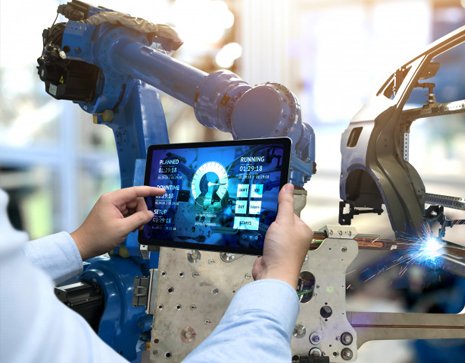How Industrial Automation AI Simplifies ERP Integration for Smarter Manufacturing
Enterprise Resource Planning (ERP) systems like SAP, Oracle NetSuite, and Microsoft Dynamics are critical for managing manufacturing workflows, supply chain logistics, and financial operations. However, disconnected ERPs lead to manual data entry, inconsistent inventory tracking, and delayed decision-making.
Industrial Automation AI bridges this gap with AI-driven ERP integration tools. This article explains how our platform connects ERPs, automated workflows, and empowers manufacturers to scale efficiently—even if you’re new to automation.

What is ERP Integration? Streamlining Data Flow Across Systems
ERP integration connects your ERP software with other tools (e.g., CRM, inventory systems, AI agents) to automate data sharing. Think of it as a digital bridge that lets systems "talk" to each other without manual intervention.
Why ERP Integration Matters for Manufacturers
- Eliminate manual tasks: Automate order entry, invoice matching, and inventory updates.
- Reduce errors: AI validates data before syncing to ERPs like SAP or Infor.
- Unify siloed data: Sync sales, production, and logistics data across departments.
Example:
A Midwest auto parts manufacturer reduced order processing time by 70% after integrating Industrial Automation AI with their SAP ERP. Orders from PDFs and emails now auto-populate into SAP, with AI flagging stock shortages in real time.
How Industrial Automation AI Connects with ERPs
Our platform uses pre-built connectors, APIs, and machine learning to integrate with ERPs of all sizes—from legacy systems to cloud-based tools like Oracle NetSuite.
Step 1: Connect ERPs with Pre-Built or Custom Connectors
- Pre-built connectors: For SAP, Oracle, Microsoft Dynamics, Infor, and Epicor. Set up in <1 hour.
- Custom APIs: For niche or legacy ERPs (e.g., Epicor Eclipse). Our engineers build secure connectors tailored to your system.
How It Works:
- Grant read/write access to your ERP (we use encrypted credentials).
- Select data types to sync (orders, invoices, inventory levels).
- AI tests the connection to ensure accuracy.
Step 2: Train AI to Understand Your ERP Workflows
Upload sample data to teach the AI:
- Sales orders: Formats, SKUs, pricing rules.
- Business logic: “Orders under 500 units route to Warehouse A.”
Example:
A food distributor trained the AI using 200 PDF invoices. The system now extracts supplier details, amounts, and due dates—auto-populating them into Microsoft Dynamics 365 with 99% accuracy.
Step 3: Automate Cross-ERP Workflows
- Order processing: Extract data from emails/PDFs → Validate → Enter into SAP.
- Multi-ERP sync: Update inventory in Oracle when sales are logged in Infor.
- Error handling: Alert teams if orders exceed stock limits in Epicor Prophet 21.
Integrating Multiple ERPs? A Step-by-Step Guide
Many manufacturers use separate ERPs for sales, production, and finance. Here’s how to unify them:

Syncing SAP (Sales) + Infor (Inventory)
- Challenge: Orders in SAP often oversold stock tracked in Infor.
- Solution:
- Connect both ERPs to Industrial Automation AI.
- AI checks Infor’s stock levels in real time before confirming SAP orders.
- Auto-updates both systems post-purchase.
- Result: Zero overselling, 30% faster order fulfillment.
Global Manufacturer with Regional ERPs
- Challenge: European plants used SAP; Asian plants used Oracle. Data reconciliation took weeks.
- Solution:
- Sync all ERPs to a centralized AI dashboard.
- AI converts orders (€/$) and inventory metrics into a unified format.
- Generates global reports in hours.
- Result: 50% faster financial closing cycles.

Key Features for Non-Technical Teams
Drag-and-Drop Rule Builder
Define workflows without coding:
- “If an order arrives via email → Validate → Send to SAP.”
- “If inventory < 100 in Oracle → Alert manager.”


Real-Time Dashboards
Track all ERPs in one place:
- Orders processed per hour.
- Top error sources (e.g., mismatched SKUs).
- Inventory levels across warehouses.
Automatic Error Resolution
- Example: If a PDF order lacks a delivery date, the AI emails the customer for clarification.

Security & Compliance: Protecting Your Data
End-to-End Encryption
Role-Based Access
Audit Logs

Answering Common ERP Integration Questions
Yes. Our custom APIs support legacy systems. A client integrated a 20-year-old ERP in 3 weeks.
Most workflows are automated within 7–14 days after uploading sample data.
The AI syncs data across all ERPs, ensuring consistency in sales, inventory, and logistics.
No. Pre-built connectors and drag-and-drop tools let non-technical teams set up workflows.
The AI standardizes data (e.g., currency, units) and reconciles discrepancies automatically.
How Manufacturers Transformed Their Workflows
Automotive Supplier Cuts Costs by 40%


